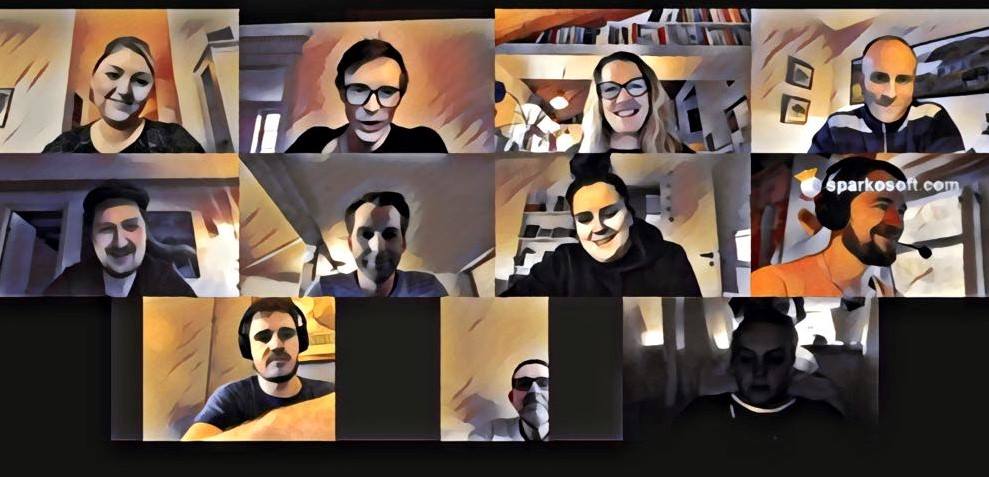
The digital and technological development opens up new ways of creative work processes stimulated by virtual forms of collaboration and participation, but how do we take advantage of this potential?
Based on our teaching background in Danish lower and secondary schools, we have often experienced schools investing in digital resources, but in many cases, they are rarely used, maybe due to both the limited time for developing the necessary competencies and the limited access to and availability of corresponding IT supervision.
Our experience with participating in and setting up online dialogues, inspired us to experiment with IT knowledge sharing within domestic borders without having to be physically present. We wanted to explore whether it is possible to create new ways of sharing knowledge among teachers and anyone interested in educational technologies in the pursuit of achieving greater profitability and ultimately leading to a wider network and new alliances. Alliances that internally ideally would support expanding IT competencies and externally would use technology even more wisely in education.
Recruiting participants
To recruit participants for our Playful Online Dialogue we used Facebook which contains various groups consisting of people interested in IT and teaching. We chose a group called ‘IT og undervisning’ (IT and Teaching) to post in our request. Quickly, two handfuls of group members showed interest, and we decided on carrying out the idea hoping that even more participants would join.
For setting up the dialogue we used Zoom as it has several positive features in relation to our intentions:
- We intended to include an unknown number of participants, the more the merrier, and the limit of Zoom at 100 had great potential.
- The fact that Zoom is available for everyone to download and thus can be used with whichever email the participants wish to use was interesting in our setup because we did not know in advance who exactly was going to participate.
- As we knew some of the presenters were introducing digital software programs on their computer the simultaneous screen share feature was a relevant option to weight.
- As for the collective communication we found the active speaker view, the option of gallery view, and the chat function valuable.
- The raise hand function could also have been useful, but during the actual session it turned out that the participants simply just raised their hand analogously and visibly on the screen which worked out well.
- The possibility to file share through the chat turned out to be useful as the participants had links and files they were willing to hand out in the chat forum.
Step Guide
In case you find interest in setting up your own Playful Online Dialogue similar to ours we present to you a step guide which helps you to organize the experience smoothly:
Before:
Step 1: Research the interest in the topic/IT-jamsession e.g in facebook groups.
Step 2: Recruit participants among the interested.
Step 3: Agree on the time frame.
Step 4: Agree on the number of presentations.
Step 5: Delegate the presentations
Step 6: Organize the order of the presentations.
Step 7: Inform the participants about the structure, access to the session, exact time frame and briefly about content.
Step 8: Make sure you have a backup plan if for whatever reason some of the presenters do not show up.
Step 9: Go through and try out the Zoom functions you plan to use.
Step 10: Distribute roles in your group if possible (e.g. tutors, chat responsibles, technological masters, inquisitive Toms or other relevant parts).
Step 11: Distribute the Zoom link for the session 15-20 minutes before the session begins.
Under:
Step 1: Make sure everyone agrees both to having the session recorded and to having the recording broadcasted for other interested to watch.
Step 2: Greet the participants and go through the relevant Zoom functions used during the session and how you would like them to be used.
Step 3: Briefly introduce yourselves (the group).
Step 4: Describe the structure of the session in short.
Step 5: Introduce the presenters and be thankful for their contribution.
Step 6: Stick to the described timeframe and structure of the session.
Step 7: Round of politely by thanking the presenters and participants for their participation.
Step 8: Before you close Zoom we highly recommend to give a request among the participants to stay in the Zoom for a few more minutes and give you feedback on their experience.
After:
Step 1: Broadcast the video in relevant context (e.g. IT & Learning Facebook groups)
Step 2: Perform interviews with two different participants respectively a presenter and a listener.
Step 3: Reflect on the sessionen and the interviews.
Step 4: Make any relevant adjustments that may rise in the light of the reflections.
So, how did it go?
After carrying out the online dialogue, we made two individual interviews with two of the participants, one presenter of a technology and one listener, to evaluate on the pedagogical setup and to get a deeper understanding of the participants’ experiences with this online synchronous way of sharing knowledge. We found that both of the participants generally were positively tuned, especially concerning the potential in not only getting inspired on how to use different technologies in the classroom, but also expanding relevant professional network and hereby easy access to other “superusers”. Easy accessibility, effectiveness and the convenience of participating from home were all mentioned as parts of the reasons why both the participants were interested in trying out the setup again. Ahead of the online session, we identified the setup with 5 different presenters as a possible barrier in relation to encouraging monologism rather than dialogism, but during the session, we found that this wasn’t a problem at all as there were many curious questions along the way asked by the participators. However, we became aware that knowledge sharing is a broad wording, and it lead to some misconceptions regarding the matching of expectations as two of the presenters showed to be consultants trying to sell digital devices. As Dysthe and Samara (See One What) points out, integrity and sincerity thereby suddenly became an essential part the online dialogue particularly regarding some of the presenters’ motivation of participation.
Another essential thing that became clear to us, both during the beginning of the session and when interviewing the participants, was the courage it takes to expose yourself, laying out your knowledge, understandings and intentions when participating in this kind of playful dialogue. This was chiefly a concern for the interviewed presenter who pointed out that it was an anxiety-provoking experience turning on the microphone putting oneself into the spotlight, whereas the listener had a more relaxed experience. When creating dialogical knowledge sharing forums, this is definitely a challenging aspect of this form of communication, and therefore also an aspect which we believe demands a certain focus. We learned that creating a safe learning environment is a fundamental part of establishing playful online dialogues as participating in dialogues calls for the participants to somehow interact either being actively engaged as speakers or active listeners. Although, we were looking for dialogic activity mainly, it might be sensible to considerably allow and encourage the option to participating legitimately peripheral as that in time increasingly could lead to full participation, according to Lave & Wenger.
Do’s and Don’ts
Having the dialogue set as an important part of knowledge sharing seems to be of great importance regarding both motivation and the outcome of learning. The interaction between the participants was not as challenging to support as we had feared, although some clearly prefered to use the written chat rather than turning on the microphone to speak. If desirable perhaps one could encourage a high frequence of (oral) dialogue by not setting the scene for the written chat as much as we did. To avoid sellers of specific digital devices with economic interests among the presenters you could with advantage undertake an in depth interview with those/the chosen ones in advance both in relation to topic, intentions and motivation. Overall we highly recommend to be organized and well prepared for the session including distributing roles in the organizing group and agreements on how you would like the participants to interact (e.g. raise hands, use the chat, speak freely through the microphone and the like). A few of the participants praised the informal setting which thus go hand in hand with a well prepared setup easily.
Looking into the future we see great potentials in the concept of knowledge sharing through online, synchronous, playful, and informal dialogues. Various setups could bring value to a wide range of interested parties. Our line of approach in this specific case holds the possibility to rapidly and managebly expand the participants’ acquaintance with a wide spectrum of digital technologies. That may broaden the palette of tools to choose from in the ambition to make wise use of digital technologies in learning contexts. Some of the participants demanded an additional setup with a specific topic to discuss related to a specific teaching course and a certain group of students. This could either pass off as breakout groups after a short introduction to a number of topics or as initially separate sessions. It requires a clear description of the intentions with the dialogue to avoid expectations unmet.
Thank you for reading, we hope you found it inspirational. You’re more than welcome to post comments or new ideas on how to create future playful, dialogical, and synchronous online IT knowledge sharing.
Written by Louise Graversen & Malene Elmer

